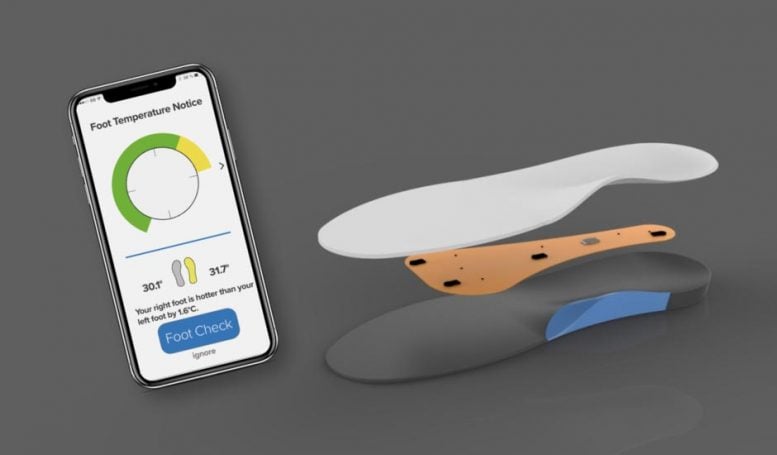
This is a product image of a smart insole with a graphene sensing system that can help detect early signs of foot ulcers before they form. Credit: Bonbouton
Stevens Institute of Technology and Bonbouton sign an exclusive license agreement to bring diabetic patients insole that could prevent ulcers.
Stevens Institute of Technology has signed an exclusive licensing agreement with Bonbouton, giving the cutting-edge health and technology company the right to use and further develop a graphene sensing system that detects early signs of foot ulcers before they form so people living with diabetes can access preventative healthcare and confidently manage their health.
The smart insole, Bonbouton’s first product, can be inserted into a sneaker or dress shoe to passively monitor the foot health of a person living with diabetes. The data are then sent to a companion app that can be accessed by the patient and shared with their healthcare provider, who can determine if intervention or treatment is needed.
“I was inspired by two things—a desire to help those with diabetes and a desire to commercialize the technology,” said Bonbouton Founder and CEO Linh Le, who developed and patented the core graphene technology while pursuing a doctorate in chemical engineering at Stevens. Le came up with the idea to create an insole that could help prevent diabetic ulcers after several personal incidents that lead him to pursue preventative healthcare.

Credit: Bonbouton
Complications from diabetes can make it difficult for patients to monitor their foot health. Chronically high levels of blood glucose can impair blood vessels and cause nerve damage. Patients can experience a lot of pain, but can also lose feeling in their feet. Diabetes-related damage to blood vessels and nerves can lead to hard-to-treat infections such as ulcers. Ulcers that don’t heal can cause severe damage to tissues and bone and may require amputation of a toe, foot, or part of a leg.
Bonbouton’s smart insoles sense the skin’s temperature, pressure, and other foot health-related data, which can alert a patient and his or her healthcare provider when an infection is about to take hold. This simplifies patient self-monitoring and reduces the frequency of doctor visits, which can ultimately lead to a higher quality of life.
Bonbouton, which is based in New York City, is currently partnering with global insurance company MetLife to determine how its smart insoles will be able to reduce healthcare costs for diabetic foot amputations. In 2018, Bonbouton also announced its technical development agreement with Gore, a company well known for revolutionizing the outerwear industry with GORE-TEX® fabric, to explore ways to integrate Bonbouton’s graphene sensors in comfortable, wearable fabric for digital health applications, including disease management, athletic performance, and everyday use.
“We are interested in developing smart clothing for preventative health, and embrace the possibilities of how our graphene technology can be used in other industries,” said Le. “I am excited to realize the full potential of Bonbouton, taking a technology that I developed as a graduate student at Stevens and growing it into a product that will bring seamless preventative care to patients and save billions of dollars in healthcare costs.”
Stevens is a shareholder of Bonbouton, legally known as FlexTraPower, and co-owns two of the seven patents filed by the company.









This is a amazing blog on this topic and it will helpful for everyone
Thanks for the sharing information and keep it up